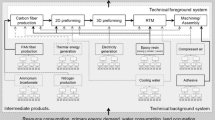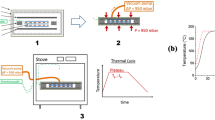Abstract
Composite materials are demonstrating the ability to face the challenge of competitive markets where high-performance, low costs, and reduced manufacturing time are mandatory. Vacuum bagging with autoclave curing is one of the most used manufacturing methods for carbon fiber composite parts. However, it shows some limitations, mainly due to manual operations and long processing time. Out-of-autoclave (OOA) methods, such as pressure bag molding (PBM), can lead to a strong reduction of the manufacturing time through the simplification of lay-up and curing phases. In this paper, a comparative analysis between the autoclave and the PBM processes has been performed, jointly considering both the economic and environmental aspects. An evaluation of the environmental impacts has been carried out following the standardized life cycle assessment (LCA) methodology. In addition, costs related to these two manufacturing techniques have been estimated through a parametric approach and successively compared. Different scenarios have been considered to take into account various production batches, mold manufacturing techniques, and end of life alternatives. The analyses show conflicting results demonstrating that a global optimum scenario does not exist and, depending on the chosen indicator and production batch, the best alternative varies. Considering only the environmental indicators, the autoclave process can be considered the most sustainable option, due to the lower consumption of energy.












Similar content being viewed by others
References
Holmes M (2017) Carbon composites continue to find new markets. Reinf Plast 61:36–40. https://doi.org/10.1016/j.repl.2016.12.060
Mathes V (2018) The composites industry: plenty of opportunities in heterogeneous market. Reinf Plast 62:44–51. https://doi.org/10.1016/J.REPL.2017.05.002
Rao S, Simha TGA, Rao KP, Ravikumar GV V. (2015) Carbon composites are becoming competitive and cost effective. Infosys website 2–3
Nickels L (2017) Composites driving the auto industry. Reinf Plast 62:38–39. https://doi.org/10.1016/j.repl.2017.11.013
Duflou JR, De Moor J, Verpoest I, Dewulf W (2009) Environmental impact analysis of composite use in car manufacturing. CIRP Ann - Manuf Technol 58:9–12. https://doi.org/10.1016/j.cirp.2009.03.077
Witik RA, Payet J, Michaud V, Ludwig C, Månson JAE (2011) Assessing the life cycle costs and environmental performance of lightweight materials in automobile applications. Compos Part A Appl Sci Manuf 42:1694–1709. https://doi.org/10.1016/j.compositesa.2011.07.024
Faster cycle, better surface: out of the autoclave : CompositesWorld. https://www.compositesworld.com/articles/faster-cycle-better-surface-out-of-the-autoclave. Accessed 17 Apr 2018
Advani SG, Hsiao K-T (2012) Manufacturing techniques for polymer matrix composites (PMCs). Woodhead Pub
Henning F, Kärger L, Dörr D, Schirmaier FJ, Seuffert J, Bernath A (2019) Fast processing and continuous simulation of automotive structural composite components. Compos Sci Technol 171:261–279. https://doi.org/10.1016/J.COMPSCITECH.2018.12.007
Summerscales J, Searle TJ (2005) Low-pressure (vacuum infusion) techniques for moulding large composite structures. Proc Inst Mech Eng Part L J Mater Des Appl 219:45–58. https://doi.org/10.1243/146442005X10238
Hwang S-S, Park SY, Kwon G-C, Choi WJ (2018) Cure kinetics and viscosity modeling for the optimization of cure cycles in a vacuum-bag-only prepreg process. Int J Adv Manuf Technol 99:2743–2753. https://doi.org/10.1007/s00170-018-2467-y
Kay J, Fahrang L, Hsiao K, Fernlund G (2011) Effect of process conditions on porosity in out-of-autoclave prepreg laminates. In: 18Th international conference on composite materials
Liu S, Li Y, Shen Y, Lu Y (2019) Mechanical performance of carbon fiber/epoxy composites cured by self-resistance electric heating method. Int J Adv Manuf Technol 103:3479–3493. https://doi.org/10.1007/s00170-019-03707-0
Crivelli Visconti I, Langella A (1992) Analytical modelling of pressure bag technology. Compos Manuf 3:3–6. https://doi.org/10.1016/0956-7143(92)90176-U
Mitchell P, Society of Manufacturing Engineers (1996) Tool and manufacturing engineers handbook. Volume 8, plastic part manufacturing: a reference book for manufacturing engineers, managers, and technicians. In: Society of Manufacturing Engineers
Park S, Lee D, Song J (2018) Fabrication and evaluation of mechanical properties of carbon/epoxy square tube using pressure bag molding and compared with autoclave method. Int J Precis Eng Manuf 19:441–446. https://doi.org/10.1007/s12541-018-0053-8
Drozda T, Wick C, Benedict JT, et al (1983) Tool and manufacturing engineers handbook: a reference book for manufacturing engineers, managers, and technicians. Society of Manufacturing Engineers
Duflou JR, Deng Y, Van Acker K, Dewulf W (2012) Do fiber-reinforced polymer composites provide environmentally benign alternatives? A life-cycle-assessment-based study. MRS Bull 37:374–382. https://doi.org/10.1557/mrs.2012.33
Suzuki T, Takahashi J (2005) Prediction of energy intensity of carbon fiber reinforced plastics for mass-produced passenger cars. Ninth Japan Int SAMPE Symp JISSE-9:14–19
Song YS, Youn JR, Gutowski TG (2009) Life cycle energy analysis of fiber-reinforced composites. Compos Part A Appl Sci Manuf 40:1257–1265. https://doi.org/10.1016/j.compositesa.2009.05.020
Witik RA, Gaille F, Teuscher R, Ringwald H, Michaud V, Månson JAE (2012) Economic and environmental assessment of alternative production methods for composite aircraft components. J Clean Prod 29–30:91–102. https://doi.org/10.1016/j.jclepro.2012.02.028
Tong R, Hoa SV, Chen M (2011) Cost analysis on L-shape composite component manufacturing. In: Proc 18th Int Conf Compos Mater 1–5
Baskaran M, Sarrionandia M, Aurrekoetxea J, et al (2014) Manufacturing cost comparison of RTM, HP-RTM and CRTM for an automotive roof. ECCM16 16th Eur Conf Compos Mater 22–26
Vita A, Castorani V, Germani M, Marconi M (2018) Comparative life cycle assessment of low-pressure RTM, compression RTM and high-pressure RTM manufacturing processes to produce CFRP car hoods. Procedia CIRP
Potter K, Bloom D, Crowley D, et al (2017) Automating the manufacture of very complex composite structures. In: ICCM International Conferences on Composite Materials. pp 20–25
Louis BM (2010) Gas transport in out-of-autoclave prepreg laminates. THE UNIVERSITY OF BRITISH COLUMBIA
Arafath ARA, Fernlund G, Poursartip A (2009) Gas transport in prepregs: model and permeability experiments. Proc 17th Int Conf Compos Mater 1–9
Slesinger N, Shimizu T, Arafath ARA, Poursartip A (2009) Heat transfer coefficient distribution. ICCM 17th, 27 Jul - 31 Jul 1–10
Anderson JP, Altan MC (2012) Properties of composite cylinders fabricated by bladder assisted composite manufacturing. J Eng Mater Technol 134:044501. https://doi.org/10.1115/1.4007017
Kar KK (2016) Composite materials: processing, applications, characterizations. Springer Berlin Heidelberg, Berlin
Vita A, Castorani V, Mandolini M, Papetti A, Germani M (2019) Cost and temperature homogeneity optimization of the heating system for composite materials air press molding. Comput Des Appl 16:1084–1097. https://doi.org/10.14733/cadaps.2019.1084-1097
ISO-International Organization for Standardization (2006) Environmental management—life cycle assessment—principles and framework. ISO EN:14040
ISO-International Organization for Standardization (2006) Environmental management—life cycle assessment—requirements and guidelines. ISO EN 14044
Wernet G, Bauer C, Steubing B, Reinhard J, Moreno-Ruiz E, Weidema B (2016) The ecoinvent database version 3 (part I): overview and methodology. Int J Life Cycle Assess 21:1218–1230. https://doi.org/10.1007/s11367-016-1087-8
Duverlie P, Castelain JM (1999) Cost estimation during design step: parametric method versus case based reasoning method. Int J Adv Manuf Technol 15:895–906. https://doi.org/10.1007/s001700050147
Khalil YF (2017) Eco-efficient lightweight carbon-fiber reinforced polymer for environmentally greener commercial aviation industry. Sustain Prod Consum 12:16–26. https://doi.org/10.1016/j.spc.2017.05.004
(2016) EUROPEAN ALUMINIUM, Recycling aluminium a pathway to a sustainable economy. https://www.european-aluminium.eu/media/1712/ea_recycling-brochure-2016.pdf. Accessed 22 Feb 2019
Goedkoop M, Heijungs R, De Schryver A, et al (2013) ReCiPe 2008. A LCIA method which comprises harmonised category indicators at the midpoint and the endpoint level. Characterisation. A life cycle impact … 133. http://www.lcia-recipe.net. Accessed 8 Feb 2019
Solomon S, Qin D, Manning M et al (2007) IPCC, 2007: climate change 2007: the physical science basis. Contribution of Working Group I to the Fourth Assessment Report of the Intergovernmental Panel on Climate Change, Cambridge
Acknowledgments
The authors acknowledge the support offered by HP Composites s.r.l. (Ascoli Piceno, Italy) for the data retrieval.
Author information
Authors and Affiliations
Corresponding author
Additional information
Publisher’s note
Springer Nature remains neutral with regard to jurisdictional claims in published maps and institutional affiliations.
Rights and permissions
About this article
Cite this article
Vita, A., Castorani, V., Germani, M. et al. Comparative life cycle assessment and cost analysis of autoclave and pressure bag molding for producing CFRP components. Int J Adv Manuf Technol 105, 1967–1982 (2019). https://doi.org/10.1007/s00170-019-04384-9
Received:
Accepted:
Published:
Issue Date:
DOI: https://doi.org/10.1007/s00170-019-04384-9




